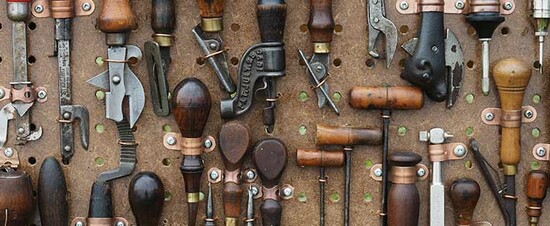From planes and saws to levels, wrenches, and rules, old hand tools are the pride and joy of many a collector’s possessions. Not only do they represent a bygone era of simple, traditional craftsmanship, but they are also highly sought after for their practical value. Depending on the condition of the tool and its type, a good piece can be worth hundreds of dollars - making them an attractive choice for prospective collectors everywhere.
If you’re interested in joining the ranks of antique tool collectors, there are several things you should look out for when looking through potential acquisitions. Firstly, it is important to distinguish between ‘antique’ and ‘vintage’ tools. Generally speaking, ‘antique’ describes items made before 1850 whereas ‘vintage’ refers to those from 1900 onwards. Therefore, when buying these pieces it is essential to learn about their age so that you can accurately assess their authenticity and value.
Planes
Wood planes are one of the most sought-after collectable hand tools for any carpenter or woodworker. Used in a variety of ways, these tools are invaluable for cutting and shaping boards of wood. Traditionally, carpenters made their own planes with blades that were bought from blacksmiths, or carved decorative elements or initials into the plane itself. This added personalisation made these tools even more valuable, as it created a unique story that was passed down through generations.
In the days before mass production, wood planes were crafted by hand with detailed designs and intricate patterns. Each artisan would create their own style and signature designs which could be identified in the grain of the wood as well as in the ornamental details. As such, these handcrafted planes can command higher prices than those manufactured through modern methods.
With such intricate craftsmanship put into each piece, many antique wood planes can still be used to cut and shape boards today. Depending on how well they have been maintained over time, some may require a bit more maintenance to get them back up to their peak performance. With proper care, however, these vintage tools can last for generations - creating family heirlooms for future generations to admire and collect.
Saws
There are numerous styles of vintage saws that may be of interest to collectors, including crosscut saws, rip saws and backing saws. Disston is a renowned manufacturer of antique handsaws, and collectors can identify these particular saws by the stamped name on the spine and a gold medallion on the handle bearing a small insignia. Founded in 1840 by Henry Disston in Philadelphia, Pennsylvania, Disston tools have been crafted with quality materials and innovative features such as alloy steel blades and comfortable handles that provide an even distribution of weight.
In addition to producing some of the finest hand tools available at the time, Disston also introduced new designs like tapered ground steel teeth which helped improve cutting speed as well as accuracy. As one of the first manufacturers to open its own factory, Disston also set industry standards for quality control that are still followed today by modern tool companies.
Collectors seeking authentic pieces often look for unique details like wooden handles made from popular woods like apple or maple. And depending on their condition, certain models may be worth more than others due to their rarity or design features. Nevertheless, regardless of the age or type of antique saw you’re looking for, Disston remains one of the top names in vintage hand tools that any collector would be proud to own.
Hand Drills
Hand drills are a common antique tool that can be found in many collections. They come in a variety of shapes, sizes, and styles, all of which have their own unique value to the collector. Typically made of wood, steel or iron, they were designed to provide users with a reliable way to drill into the material, such as wood or metal.
Early hand drills were often made from a single piece of wood and had an adjustable chuck at one end and a crank handle at the other. This allowed for adjustable drilling depths and speeds depending on the user’s needs. As time went on, different styles began to emerge including two-piece wooden drills that were much easier to use than their predecessors.
The most prized examples are those crafted from iron or steel, which could be used with both soft and hard materials like stone, brick or mortar; something earlier models were unable to do. They also featured additional components such as chuck plates which would hold the bit securely in place during use. Additionally, some models included quick change chucks so that the bit could be swapped out quickly without any tools needed.
Due to their utility, reliability and high craftsmanship, these antique hand drills remain valuable today both for their rarity as well as for their ability to still perform useful work despite being decades old. They also often feature beautiful engravings on their handles which add further appeal among collectors looking for highly decorative pieces to add to their collections.
Plumb Bobs
A plumb bob is a weight that is suspended from a line. It hangs absolutely true, so it was always possible for workmen to find a true vertical. The first recorded use of plumb bobs goes back to ancient Egypt and Greece. Plumb bobs have been used throughout history in different ways, such as in homes and churches to ensure the walls were vertical and straight.
Antique plumb bobs often were shaped like common staples such as pears, carrots or turnips; however, there are many more varieties of antique plumb bobs – including ones crafted out of precious metals or inlaid with ivory or stones, crafted out of exotic woods, and those crafted out of brass or other metals that have been intricately worked with designs.
The oldest known example of an antique plumb bob is estimated to be from the 9th century AD, it was discovered at Paderborn Cathedral Germany. Some other examples include a 17th-century English example made from silver gilt which was found at an auction house in London and several Italian examples from later centuries which were constructed using brass with decorative knurls on the upper half and wooden handles decorated with metal rings below.
Plumb bobs can come in all sorts of sizes – the smallest known one being only 1/3-inch long while the largest known one was 6 inches (15 cm) long! The most common material used for these tools is iron but some antique examples also include lead, bronze, brass, steel, gold and silver. Collectors look for several different factors when evaluating antique plumb bobs; this includes age, material type and quality craftsmanship (such as any intricate engravings).
Overall antique plumb bobs are incredible artefacts that demonstrate not just the ingenuity but also the level of care craftsmen put into work even centuries ago. They truly are remarkable pieces of art that provide insight into our past; something that any collector would be proud to add to their collection!


Comments
There are no comments yet. Login or Register and write an article comment